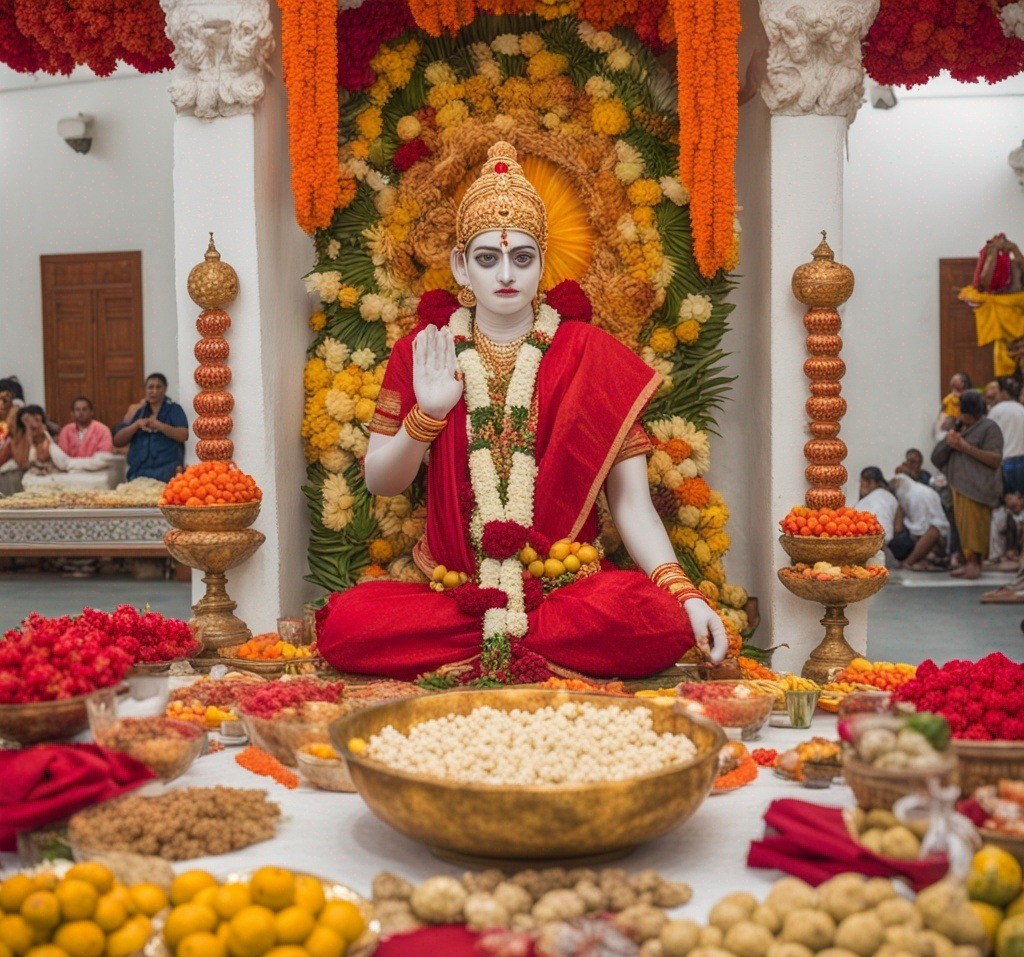Lalita Sahasranama Puja
About the Puja

Lalita Sahasranama Puja is among the important ceremonies in Hindu worship, where Goddess Lalita Tripurasundari, the essence of Adi Shakti or the divine feminine supremacy, is venerated. The meaning of "Lalita" is beauty, playfulness, and compassion. "Sahasranama" means one thousand names.
The Lalita Sahasranama is a hymn in the Brahmanda Purana called upon in worship to invoke the Goddess Lalita's blessings for prosperity, wisdom, well-being, and enlightenment.
Devotees performing this puja invariably seek the blessings of the divine mother to bring them good fortunes, harmonious lives, and spiritual development. Navratri days, Fridays, full moon days, and solemn occasions like marriage, childbirth, or house warming will all appeal to invoke this puja in people.
Significance of Lalita Sahasranama Puja
The Lalita Sahasranama Puja has great spiritual and astrological significance. Goddess Lalita's thousand names point to her various forms and attributes and the cosmic powers she possesses, inviting her divine presence into the lives of devotees. This puja is said to fend off negative energies, black magic, and planetary misfortunes while removing obstacles in careers, health, and relationships. It promotes spiritual awakening and peace of mind as well as increased devotion and guidance for a better living.
With the puja, devotees invoke blessings for prosperity, happiness, marriage, children, and general wellbeing. With faith and devotion, reciting the Lalita Sahasranama Stotra gives strength, wisdom, and divine guidance to show the way through life's hurdles with grace and inspiration.
History Behind This Puja
The Puja traces its origin from the Brahmanda Purana, which were composed by Rishi Agastya based on his learning and teachings of Lord Hayagrva. It forms the core of Sri Vidya Upasana, and from the Sri Chakra worship, it gained great importance in South Indian temples. This puja was revived by Adi Shankaracharya and later saints, bringing it within the reach of the Tantric and Bhakti traditions.
Over centuries, it became a key ritual in homes and temples, especially during Navaratri, Fridays, and full moon days. Devotees chant the 1,000 names of Goddess Lalita for divine blessings, spiritual awakening, and prosperity. It remains firm in the practice of Shaktism and Sri Vidya.
Offerings Made in the Puja
Offerings are a key element of the Lalita Sahasranama Puja since they speak of devotion and gratitude while increasing the spiritual vibrations surrounding the ritual.
Auspiciousness is suggested to be most in fresh flowers, particularly red and white; fruit and sweets include bananas, coconuts, jaggery, modaks, laddoos, and honey, which are offered in return for blessings from the chosen deity.
Kumkum and turmeric are used for tilak and as holy offerings to the goddess. Dhoop (incense) and deepam (lamps) purify the surroundings and invite divine potency, while Ganga Jal (Holy Water) is used for purification and Abhishekam (sacred bath).
Another important offering is Panchamrit, a sacred mix of milk, honey, ghee, yogurt, and sugar that represents divine nourishment. Anyalong with the each of these offerings carries significant spiritual meaning, invoking divine grace which in turn strengthens the devotee's bond with the goddess.
Lalita Sahasranama Puja Vidhi
Step 1 – Purification and Preparation
The first step is to make oneself clean and ready for the puja. Devotees take a ritual bath and wear clean, traditional clothes. The puja area is cleaned and decorated with rangoli and fresh flowers. The Kalash, which is held sacred, is filled with water and adorned with mango leaves and coconut.
Step 2 – Invocation of Goddess Lalita
The priest, or in some cases some of the devotees, chants Vedic mantras to invoke the goddess. A Sri Yantra or some image/idol of the goddess is placed for worship. The sankalpa should mention the intent of the puja.
Step 3 – Recitation of Lalita Sahasranama
The 1000 names of Goddess Lalita are chanted with devotion and joy. Offerings of flowers, kumkum, turmeric, and sandalwood paste are made against each name. Deepam and dhoop lightings are performed.
Step 4 – Abhishekam (Holy Bathing Ritual)
The idol is bathed with milk, honey, panchamrit, and holy water. Hymns from the Lalita Sahasranama and Devi Mahatmya are recited.
Step 5 – Aarti and Prayers
Aarti is performed using camphor and ghee lamps; hymns and prayers are sung to pay respect to the goddess. The devotees offer prayers for security, prosperity, and happiness.
Step 6 – Concluding Rituals
Sprinkling of the water around the Kalash is done for purification. The offering, known as prasad, is then distributed to the devotees as a gesture of divine blessing. A brief, concluding prayer is recited in gratitude to Goddess Lalita.

Prasad Distribution
All prasad offered here is considered an offering of sacrifice in the puja of the Lalita Sahasranama, which provides divine blessings in the form of Goddess Lalita. Kheer, chana dal, modaks, fruits, coconut, and Panchamrit are some examples of prasads, presented first to the deity and then to the devotees.
Sharing prasad with family, friends, and the needy is an act of charity that spreads divine grace far beyond the puja. Eating prasad helps purify one's mind and body besides granting fortune, spiritual upliftment, and a good connection to the goddess.
Conclusion
This is the powerful invocation to Shakti that represents the Goddess Lalita Sahasranama Puja for prosperity, protection, and inner peace. Puja practiced with faith and devotion relieves negativity in one's life and imparted divinity with the resultant right and all-around wellness.
Many of the devotees practicing this sacred ritual find their relationship with the goddess and are filled with joy, success, and satisfaction in their spiritual lives. Om Namo Bhagavate Saraswatiyai Namah May Goddess Lalita bless all those who chant the thousand names with pure love! Jai Maa Lalita.




